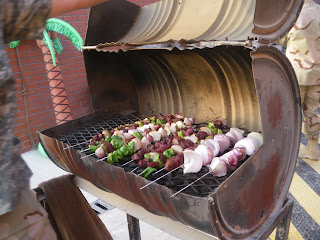Kandahar, Afghanistan
 I think we have gone beyond the Groundhog Day effect, and now we are like cogs in a big machine, no lubricant, metal on metal, grinding out one day after another. The machine moves inexorably forward, little torque forces adding up to comprise another 24 hour period.
I think we have gone beyond the Groundhog Day effect, and now we are like cogs in a big machine, no lubricant, metal on metal, grinding out one day after another. The machine moves inexorably forward, little torque forces adding up to comprise another 24 hour period.It has been particularly busy this past 24 hours. My pager barks at me incessantly. I look, I am unimpressed by its proclamations. "3 INBOUND ALPHAS. DOUBLE AMPUTATIONS. GSW TO THE HEAD." And so forth. We had 17 admissions, mostly from the trauma bay, and only 1 discharge in the last 24 hours. Nowhere near our record of 29 trauma bay admissions in one day, but a handful of work. And a lot of suffering.
I find myself wending my way to the trauma bay over and over, arriving now at the last possible minute, facemask on, bonnet on head, central line kits tucked under my arm. This morning three dead on arrival, hopeless injuries from the get-go. Dismounted IED blast victims with high traumatic amputations, one eviscerated, another with an non-survivable pelvic wound. More carnage.
 The ICU is filled with local nationals either caught in the crossfire or victims of unfortunate accidents. We have one child of 4, a young girl hit by IED fragments. Her mother died during the blast, and I have no idea where the father is. She is attended to by her grandparents, a wizened old man and his wife who lovingly take care of their grandchild. One is taken aback when one sees the old woman: she is of a sect here with whom none of us have come in contact. She is covered in beaded cloth like a gypsy but her face has tattoos shaped like crosses, made of faded blue-black circles, in the four cardinal points of her face - north, south, east, and west. She is like the witch from Snow White crossed with Mike Tyson. She is a little scary, frankly, but the love she lavishes on her child when she sleeps next to her is story-book like. Admittedly, an odd story.
The ICU is filled with local nationals either caught in the crossfire or victims of unfortunate accidents. We have one child of 4, a young girl hit by IED fragments. Her mother died during the blast, and I have no idea where the father is. She is attended to by her grandparents, a wizened old man and his wife who lovingly take care of their grandchild. One is taken aback when one sees the old woman: she is of a sect here with whom none of us have come in contact. She is covered in beaded cloth like a gypsy but her face has tattoos shaped like crosses, made of faded blue-black circles, in the four cardinal points of her face - north, south, east, and west. She is like the witch from Snow White crossed with Mike Tyson. She is a little scary, frankly, but the love she lavishes on her child when she sleeps next to her is story-book like. Admittedly, an odd story.Across from the tattooed woman lies a child who either fell or was pushed into a cauldron of boiling water. His little 5 year body is covered with burns, just less than 50% of his total body surface area. The standard for comfort care in the case of burns, i.e. zero percent survival here in theater, is 50%. He lies there like a mummy in his gauze bandages on his torso and extremities, a machine breathing for him. I don't know where the rumor began that he was pushed - perhaps someone made it up. But it would not surprise me, unfortunately. Nothing is shocking here. Not now, not after 6 months.













































